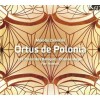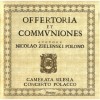Composers
Mikołaj Zieleński (Zelenscius, birth and death dates unknown) was a Polish composer, organist and Kapellmeister to the primate Baranowski, Archbishop of Gniezno.
Zieleński's only known surviving works are two 1611 liturgical cycles of polychoral works, the Offertoria/Communes totius anni. These were dedicated to the Archbishop of Gniezno, Wojciech Baranowski. The whole comprises eight part-books and a ninth book, the Partitura pro organo, which constitutes the organ accompaniment. This publication contains in all 131 pieces written for various vocal and also vocal and instrumental ensembles, all with organ accompaniment.
The Venetian publication does not only comprise the offertories and communions; we find there also over a dozen other pieces, such as hymns, antiphons, a magnificat, and even three instrumental fantasias. In his compositions Zieleński relies on his own creative invention and does not, in general, make use of the cantus firmi. The few pieces which a pre-existent melody may be traced out are based not on a plainsong melody but on the melodies of Polish songs. The sets consist of large-scale double- and triple-choir antiphons, as well as some monodic works typical of the Seconda pratica style of early Monteverdi. Zieleński's music is the first known Polish music set in the style of the Baroque.
Recently Added
Biography
Mikołaj Zieleński (Zelenscius, birth and death dates unknown) was a Polish composer, organist and Kapellmeister to the primate Baranowski, Archbishop of Gniezno.
Zieleński's only known surviving works are two 1611 liturgical cycles of polychoral works, the Offertoria/Communes totius anni. These were dedicated to the Archbishop of Gniezno, Wojciech Baranowski. The whole comprises eight part-books and a ninth book, the Partitura pro organo, which constitutes the organ accompaniment. This publication contains in all 131 pieces written for various vocal and also vocal and instrumental ensembles, all with organ accompaniment.
The Venetian publication does not only comprise the offertories and communions; we find there also over a dozen other pieces, such as hymns, antiphons, a magnificat, and even three instrumental fantasias. In his compositions Zieleński relies on his own creative invention and does not, in general, make use of the cantus firmi. The few pieces which a pre-existent melody may be traced out are based not on a plainsong melody but on the melodies of Polish songs. The sets consist of large-scale double- and triple-choir antiphons, as well as some monodic works typical of the Seconda pratica style of early Monteverdi. Zieleński's music is the first known Polish music set in the style of the Baroque.




